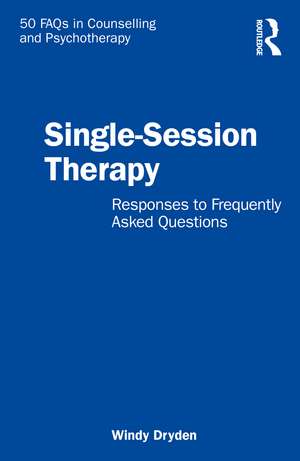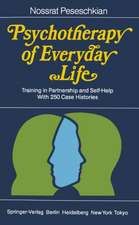Single-Session Therapy: Responses to Frequently Asked Questions: 50 FAQs in Counselling and Psychotherapy
Autor Windy Drydenen Limba Engleză Paperback – 21 dec 2021
The book focuses on 50 FAQs and is divided into five parts:
• Part 1: The Nature of Single-Session Therapy
• Part 2: The Foundations of Single-Session Therapy Practice
• Part 3: The Practice of SST
• Part 4: Critical Questions about SST
• Part 5: Miscellaneous Questions
Aimed at counsellors and psychotherapists of all orientations in training and practice, Single-Session Therapy: Responses to Frequently Asked Questions is a concise and readable source of therapeutic knowledge.
| Toate formatele și edițiile | Preț | Express |
|---|---|---|
| Paperback (3) | 112.47 lei 43-57 zile | +7.12 lei 6-12 zile |
| Taylor & Francis – 24 oct 2023 | 145.09 lei 22-36 zile | +7.12 lei 6-12 zile |
| Taylor & Francis – 7 feb 2019 | 112.47 lei 43-57 zile | |
| Taylor & Francis – 21 dec 2021 | 190.51 lei 43-57 zile | |
| Hardback (2) | 753.69 lei 43-57 zile | |
| Taylor & Francis – 12 feb 2019 | 753.69 lei 43-57 zile | |
| Taylor & Francis – 24 oct 2023 | 819.54 lei 43-57 zile |
Preț: 190.51 lei
Preț vechi: 200.54 lei
-5% Nou
Puncte Express: 286
Preț estimativ în valută:
36.46€ • 37.92$ • 30.10£
36.46€ • 37.92$ • 30.10£
Carte tipărită la comandă
Livrare economică 14-28 aprilie
Preluare comenzi: 021 569.72.76
Specificații
ISBN-13: 9781032157368
ISBN-10: 1032157364
Pagini: 192
Ilustrații: 4 Tables, black and white
Dimensiuni: 129 x 198 x 10 mm
Greutate: 0.2 kg
Ediția:1
Editura: Taylor & Francis
Colecția Routledge
Seria 50 FAQs in Counselling and Psychotherapy
Locul publicării:Oxford, United Kingdom
ISBN-10: 1032157364
Pagini: 192
Ilustrații: 4 Tables, black and white
Dimensiuni: 129 x 198 x 10 mm
Greutate: 0.2 kg
Ediția:1
Editura: Taylor & Francis
Colecția Routledge
Seria 50 FAQs in Counselling and Psychotherapy
Locul publicării:Oxford, United Kingdom
Public țintă
Postgraduate and ProfessionalCuprins
Introduction; Part 1: The Nature of Single-Session Therapy; Question 1: What is Single-Session Therapy?; Question 2: Why is it Called Single-Session Therapy if Further Sessions are Available?; Question 3: What are the Differences, If Any, Between Single-Session Therapy (SST) and One-At-A-Time (OAAT) Therapy?; Question 4: Is Single-Session Therapy Psychotherapy? Is it Counselling?; Question 5: Is Single-Session Therapy an Approach to Therapy?; Question 6: What is Meant by Single-Session Thinking?; Part 2: The Foundations of Single-Session Therapy Practice; Question 7: How Can a Therapy Agency Integrate Single-Session Therapy into its Overall Service Delivery?; Question 8: Can a Therapist Form an Effective Therapeutic Relationship with a Client in Single-Session Therapy?; Question 9: How Can a Therapist Develop a Relationship of Depth with Their SST Clients?; Question 10: How is a Client's Suitability for SST Assessed?; Question 11: Is it Possible to Practise SST when a Therapist is Required to Carry Out an Assessment?; Question 12: Why Would a Client Seek Single-Session Therapy?; Question 13: Is SST Suitable for a Client Who Wants to Explore a Problem Rather than Solve a Problem?; Question 14: Which Client Problems are Suitable and Which are Unsuitable for SST?; Question 15: Can SST be Used with Clients Who Have Severe, Complex or Chronic Problems or Is It Only Suitable for Simple Problems?; Question 16: What Does a Therapist Need to Know About a Client Beforehand to Practise SST?; Part 3: The Practice of SST; Question 17: Is Single-Session Therapy for All Clients?; Question 18: Can a Therapist Work Productively in SST with a Client Who Cannot Easily Pinpoint a Specific Problem They Wish to Tackle?; Question 19: Can Clients Get What They Need From SST?; Question 20: Which Client Factors Contribute to a Good Outcome or a Poor Outcome in SST?; Question 21: What Does a Client Need to Know about SST Beforehand to Get the Most from the Session?; Question 22: Can a Client Be Helped to Prepare for the Session in SST?; Question 23: What is the Best Way to Start a Session in SST?; Question 24: Are Sessions in SST Longer than Sessions in Ongoing Therapy?; Question 25: How Does a Therapist Manage Risk in SST?; Question 26: Which Therapist Factors Contribute to A Good Client Outcome from SST and Which Therapist Factors Contribute to a Poor Client Outcome?; Question 27: What Tips Can You Give to Help Therapists Become Focused and Stay Focused in the Session?; Question 28: What Do Therapists Most Struggle with When Practising SST?; Question 29: Can All Therapists Practise SST?; Question 30: Is SST Easier to Practise than Longer-Term Therapy?; Question 31: Is There a Protocol to be Followed While Practising SST?; Question 32: Suppose the Modal Number of Sessions is One and 70%-80% of These Clients Find that Session Sufficient Given Their Current Circumstances. Given that in Most Therapies, the First Session is Taken Up with History-Taking and Assessment Rather than Therapy, Does This Mean that These Clients Who Attend Once are Helped by a Single Session of History-Taking and Assessment?; Question 33: How Can a Therapist Best Bring a Single Session to an End?; Question 34: How Does a Therapist Know When to Offer a Client Further Help at the End of a Single Session?; Question 35: In Which Formats and With Which Client Groups Can SST Be Used?; Question 36: Can Clients Be Harmed in SST?; Part 4: Critical Questions about SST; Question 37: Treatment Protocols are Based on the Idea that Therapy for Specific Conditions Should Have a Set Number of Sessions (e.g. 12 or 16 Sessions). Doesn't This Conflict with SST?; Question 38: Doesn't SST Involve a Therapist Cramming Several Sessions Into One?; Question 39: Isn't SST Crisis Intervention?; Question 40: Does SST Only Lead to Superficial Change, Given that Real Change Happens Slowly and Gradually?; Question 41: Doesn't SST Help Clients Deal with Their Presenting Problems Rather than with Their Real Underlying Problems?; Question 42: Isn't SST Just a Sticking-Plaster Solution or A Quick Fix?; Question 43: Does SST Restrict Clients' Access to Therapy?; Question 44: Isn't SST Used for Purely Pragmatic Reasons such as to Bring Down Waiting Lists and to Save Agencies Money? If So, What Are the Implications for Clients and Therapists?; Part 5: Miscellaneous Questions; Question 45: Is SST on the Curriculum of Therapy Training Courses?; Question 46: What Training is Necessary to Practise SST?; Question 47: What Challenges Have You Faced When Practising SST?; Question 48: Which Ideas Have You Personally Found Most Useful in SST?; Question 49: How Should SST Services Be Disseminated?; Question 50: Can Single-Session Thinking Be Applied to Areas of Work Other Than Therapy?
Notă biografică
Windy Dryden, PhD, is Emeritus Professor of Psychotherapeutic Studies at Goldsmiths, University of London. He is an international authority on Rational Emotive Behaviour Therapy and is in part-time clinical and consultative practice. He has worked in psychotherapy for more than 45 years and is the author and editor of over 250 books.
Descriere
In Single-Session Therapy: Responses to Frequently Asked Questions, Windy Dryden takes the questions raised by participants from his workshops and training events on SST and provides answers in a fresh and accessible format.








